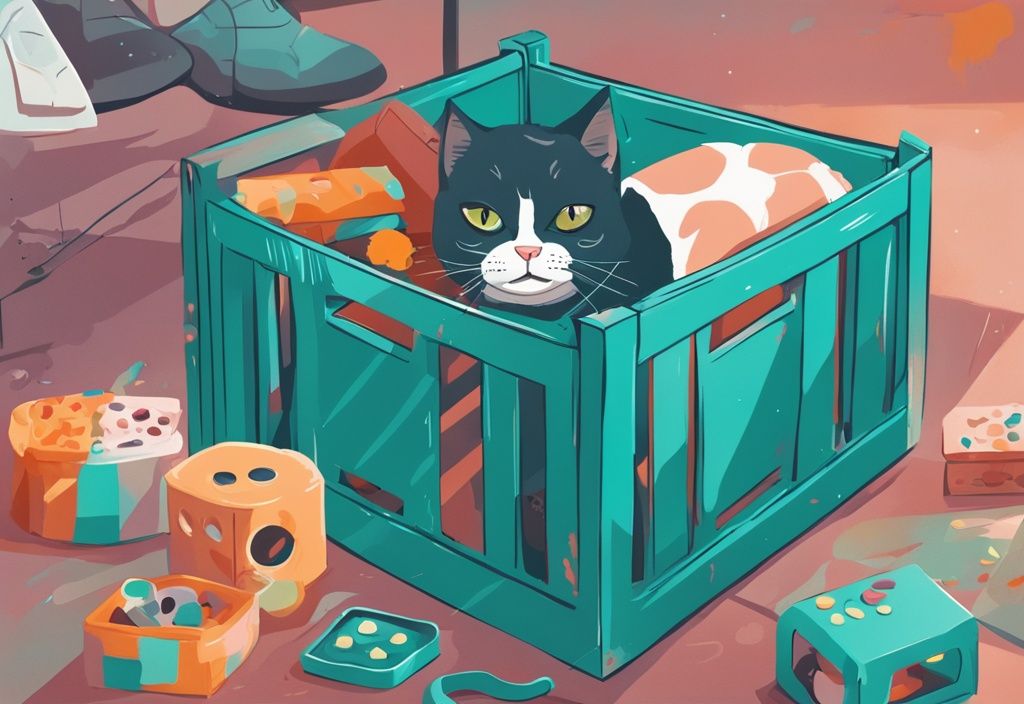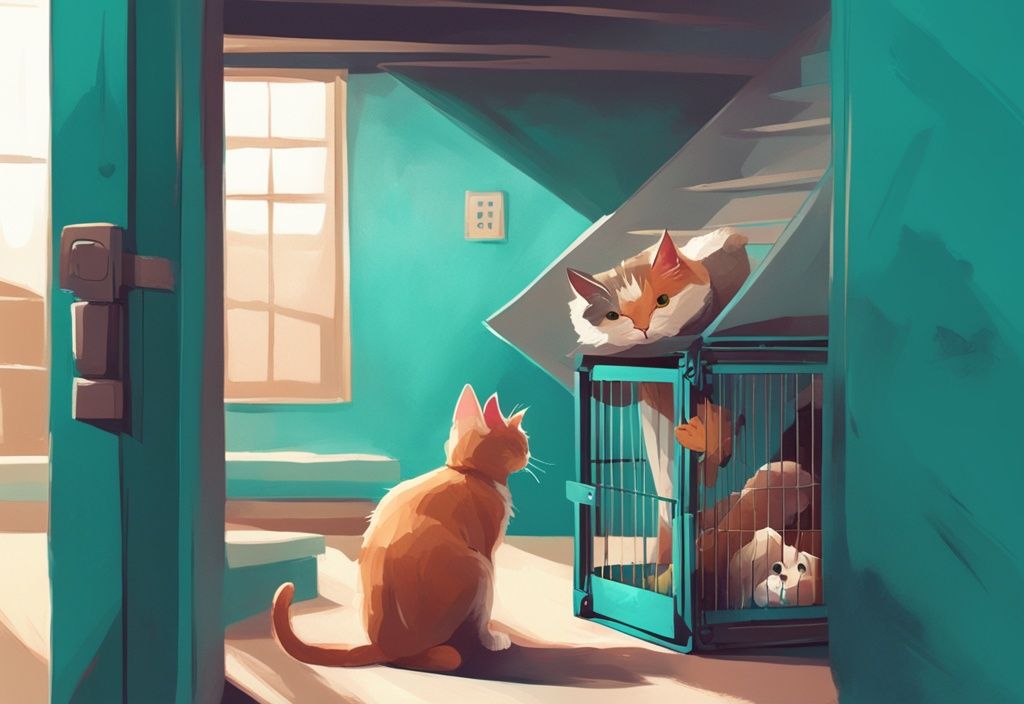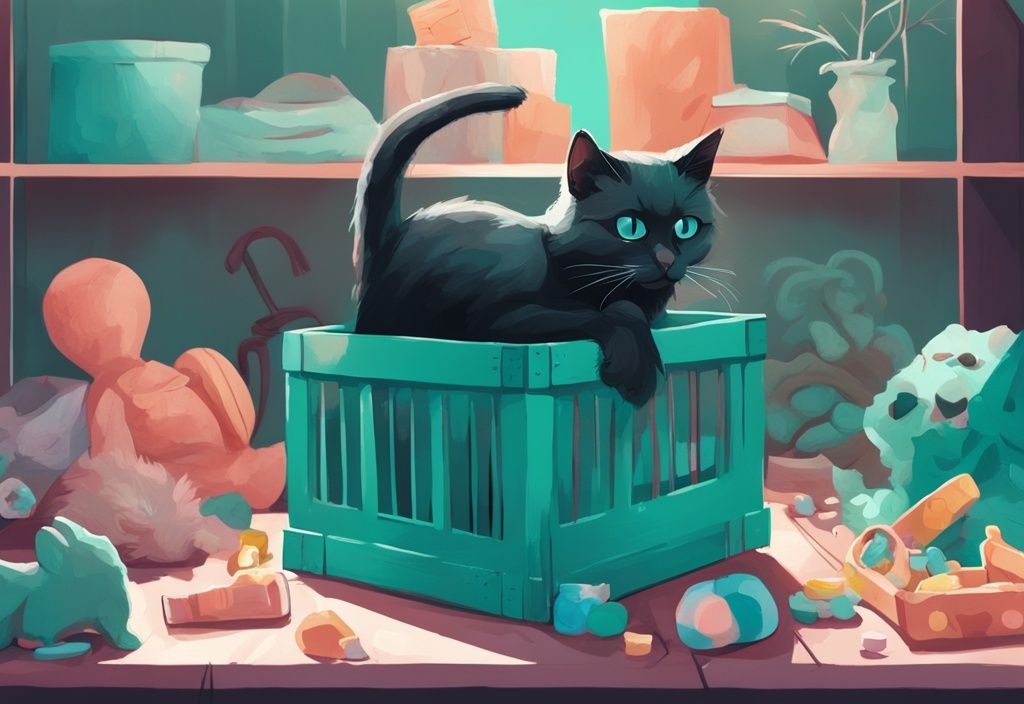When you think of crate training, dogs like my playful Border Collie, Max, might spring to mind first. But guess what? Cats, with their quirky independence, can also thrive with this method! Imagine your feline friend, like my cuddly rescue cat Whiskers, seeing their crate as a cozy nook rather than a dreaded cage. Ready to discover how this can transform your pet care routine? Let’s dive in and explore the delightful benefits of crate training for our feline companions.
Understanding Crate Training for Cats
Crate training for cats? Oh, absolutely! It’s a nifty trick that can turn a crate into a cozy little nook for your feline friend. While dogs might jump right in, cats, with their independent streak, need a bit more coaxing. But don’t worry, it’s all about patience and a gentle touch.
Think of crate training as setting up a personal retreat for your cat. Cats, like my fluffy Whiskers, thrive on routine and can get a bit frazzled when things change. A crate can be their safe haven, especially during those nerve-wracking vet visits or long road trips. Imagine having a calm kitty instead of a frazzled furball when you’re on the move!
In emergencies, a crate-trained cat can be a lifesaver. Quick evacuations become less chaotic when your cat sees the crate as a familiar friend rather than a foe. By creating a positive association with the crate, you’re giving your cat a portable piece of home. It’s like packing their favorite blanket for a sleepover—comforting and reassuring.
So, with a little patience and some tasty treats, you can help your cat embrace their crate as a place of peace and security. Trust me, it’s worth the effort!
Why Crate Training a Cat is Beneficial
Crate training a cat can be a game-changer, especially when it comes to travel and those dreaded vet visits. Imagine your feline friend, Whiskers, feeling right at home in a crate, turning what could be a stressful experience into a calm adventure. It’s like giving them their own little fortress of solitude, where anxiety takes a backseat.
But wait, there’s more! A crate isn’t just for travel. Think of it as a cat’s personal safe haven during emergencies or big moves. For those dealing with pests, ensuring the area around your cat’s feeding station is clean can be crucial. Discover effective tips on how to keep ants away from your cat’s food to maintain a comfortable and pest-free environment for your feline friend. Whether it’s a sudden evacuation or a cross-country relocation, having a crate-trained cat means you’ve got a secret weapon for keeping your pet calm and secure. It’s like having a superhero cape for your kitty, ready to swoop in during unpredictable situations.

And let’s not forget about behavior modification. A crate can be a fantastic tool for managing your cat’s antics, especially when introducing new pets or staying in a hotel. It’s like a mini classroom for your cat, where they can learn and adapt in a controlled environment. Who knew a crate could be so versatile?
When done right, crate training is a win-win for both you and your cat. It builds trust and understanding, strengthening the bond between you two. With a sprinkle of positive reinforcement and a dash of patience, you can turn the crate into a beloved part of your cat’s routine. It’s all about making pet care feel like a joyful journey, one crate at a time.
Common Misconceptions About Crate Training Cats
Crate training isn’t just for dogs, despite what many might think. You might find yourself asking, “Can you crate train a cat?” Absolutely! But it’s a whole different ball game. Cats are like the independent artists of the pet world, valuing their space and freedom. So, patience and a sprinkle of positive vibes are your best friends here. By slowly introducing the crate and turning it into a cozy haven, your feline friend can come to see it as their personal chill zone.
There’s also a myth floating around that crating is cruel. When done right, it’s more like giving your cat their own little sanctuary. Think of it as a snug retreat where they can unwind, especially when life gets a bit too loud, like during car rides or vet visits. Just make sure the crate is decked out with comfy blankets and a few favorite toys to make it inviting.
Now, unlike our canine companions, cats don’t usually need overnight crating. Their litterbox habits are top-notch, and they’re pretty good at managing their own space. So, while crate training can be a lifesaver in certain situations, it’s all about understanding your cat’s unique quirks and needs. By busting these myths, we can see how crate training can actually be a positive experience for our whiskered pals.
How to Crate Train a Cat: A Step-by-Step Guide
Choosing the Right Crate for Your Cat
Picking the perfect crate for your cat is like finding the right pair of shoes—comfort is key! The crate should be roomy enough for your kitty to stand, twirl, and stretch without feeling cramped. Think of it as their little mobile palace. Good ventilation is a must, ensuring fresh air circulates freely. And, of course, it should be secure to prevent any Houdini-style escapes. It’s a smart move to bring the crate home a few weeks before any travel plans. This gives your feline friend time to get cozy with it, easing any jitters about new surroundings.
Introducing the Crate to Your Cat
Place the crate in a peaceful spot where your cat loves to chill—maybe near their favorite sunbeam. Keep the door open at first, letting curiosity lead the way. Toss in their beloved blankets and toys, turning the crate into a familiar haven. It’s like setting up a little kitty spa, complete with all their favorite comforts.
Encouraging Exploration and Familiarity
Want to make the crate irresistible? Sprinkle some treats or a dash of catnip inside. As your cat starts to explore, shower them with praise. This positive reinforcement turns the crate into a happy place. Letting your cat nap inside strengthens these warm, fuzzy feelings.
Gradual Desensitization and Positive Reinforcement
Start by letting your cat hang out near the crate, then gently encourage them to step inside with the door open. Slowly increase the time the door is closed, always rewarding calm behavior with treats or a gentle scratch behind the ears. Remember, patience is key! Rushing can lead to a grumpy cat, and nobody wants that.
Building Up to Longer Periods in the Crate
Once your cat is comfy in their closed crate, it’s time to hit the road! Start by placing the crate in the car and spending a few quiet minutes there.

Short 5-minute drives are perfect for getting your cat used to the motion. Gradually extend these drives, and soon, your cat will be a seasoned traveler, ready for any adventure.
Overcoming Challenges in Crate Training
Crate training a cat can feel like trying to convince a fish to ride a bicycle. But with the right approach, it can be a rewarding journey for both you and your feline friend. Let’s dive into some common challenges and how to tackle them with a sprinkle of patience and a dash of creativity.
Dealing with Resistance and Stress
Ah, resistance and stress—two things cats seem to have a PhD in. If your kitty is giving you the cold shoulder, try moving the crate to a cozier corner or switch up the bedding to something more luxurious. Think of it as redecorating your cat’s new mini-apartment! Give your cat time to explore the crate at its own pace. Watch for signs of stress, like excessive meowing or hiding under the couch. If you spot these, it might be time to slow things down or sprinkle in some extra treats and cuddles. Remember, patience is key, and a little positive reinforcement can go a long way in making the crate feel like a five-star hotel.
Patience and Consistency in Training
Crate training isn’t a sprint; it’s more like a leisurely stroll through the park. Establish a regular training schedule that gently introduces your cat to the crate. Consistency is your best friend here. Use treats and praise to make the crate feel like a safe haven. And whatever you do, don’t play the villain by forcing your cat inside. This can lead to a bad rap for the crate. Instead, focus on creating a positive experience that builds trust and comfort over time. Think of it as a slow and steady waltz rather than a chaotic dance-off.
When to Seek Professional Help
Sometimes, even with the best intentions, things don’t go as planned. If crate training feels like trying to solve a Rubik’s Cube blindfolded, it might be time to call in the pros. A veterinarian or a certified feline behavior specialist can offer tailored advice to suit your cat’s unique quirks. Professional guidance can provide insights into your cat’s behavior, helping you develop a more effective training plan. With expert advice, you’ll be well on your way to a smoother and more successful crate training adventure.
Alternatives to Crate Training
When it comes to our feline friends, crate training might not always be the best fit. But don’t worry, there are some fantastic alternatives that can make both you and your cat purr with contentment. Let’s dive into a couple of these options that can help create a cozy and stress-free environment for your whiskered companion.
Using Cat Carriers
Imagine a cozy little nook that feels like home, even when you’re on the go. That’s what a cat carrier can be for your furry friend. These carriers are like the perfect travel buddy—compact yet comforting. It’s like a mini vacation spot for your cat, right in your living room! To make the carrier a welcoming space, choose one that’s comfy and secure, with plenty of ventilation and room for your cat to move around. If you’re curious about the luxurious side of feline companions, you might want to learn about what is the most expensive cat in the world. Think of it as picking the perfect Airbnb for your cat! You can make the carrier even more inviting by adding a favorite blanket or toy.
Introduce the carrier gradually, leaving it open in a familiar spot so your cat can explore at their own pace. Before you know it, your cat will see the carrier as a safe haven, making those vet visits or car rides a breeze.
Creating a Safe Room
If your cat isn’t a fan of confinement, a safe room could be the answer. Picture this: a cozy retreat where your cat can roam freely without feeling trapped. It’s like giving your cat their own little kingdom!

To set up a safe room, use pet gates or closed doors to create a secure area. This way, your cat can enjoy a sense of freedom while staying within a designated space. Equip the room with all the essentials—food, water, and a litterbox—to ensure your cat’s comfort and well-being.
A safe room is more than just a space; it’s a sanctuary that helps reduce anxiety and gives your cat control over their environment. It’s like having a little oasis of calm in your home, just for your feline friend.
FAQ
Is it necessary to crate train a cat?
Crate training might not be a must for every feline friend, but it sure can be handy! Think about those vet visits, travel adventures, or unexpected emergencies. Consider your cat’s quirks and needs to decide if this is the right path for you both.
How long does it take to crate train a cat?
Ah, the million-dollar question! The timeline can be as unique as your cat’s personality. With a sprinkle of patience and a dash of consistency, you might see progress in weeks or it could take a few months. Remember, every cat dances to their own rhythm!
What should I do if my cat refuses to enter the crate?
Got a stubborn kitty on your hands? Try enticing them with treats, toys, or a sprinkle of catnip magic. Experiment with different crate spots or cozy bedding. Whatever you do, avoid pushing them in—no one likes a forced dance partner!
Can crate training be stressful for cats?
Indeed, some cats might find it a bit ruffling. They love being the boss of their domain, after all. Keep an eye out for stress signals and be ready to tweak your approach. It’s all about making them feel comfy and safe.
Are there any alternatives to crate training?
Absolutely! You could try a trusty cat carrier or set up a safe room with limited access. Each option has its perks and might be a better fit for your kitty’s unique style. It’s all about finding what works best for your furry companion.
Conclusion
Crate training a cat? Oh, absolutely! With the right approach, a sprinkle of patience, and a dash of positive reinforcement, it’s not just possible—it’s a game-changer. While crates might scream “dog territory” to many, our feline friends can also reap some serious benefits from this practice. Picture this: a cozy, safe haven within the crate that makes travel or those dreaded vet visits a breeze, reducing stress for both you and your whiskered companion.
Now, here’s the kicker: understanding your cat’s unique personality is key. Some cats might waltz right into the crate like it’s a new adventure, while others might need a bit more coaxing. Tailoring the training to fit your cat’s temperament ensures the experience is as smooth as Whiskers’ fur after a good brushing.
And if crate training feels like trying to teach a fish to climb a tree, don’t fret! There are alternatives, like using a cat carrier or creating a safe room. These options offer flexibility and might suit some cats better, providing that snug, secure space without the crate.
In the end, whether you opt for crate training or explore other avenues, the goal is simple: boost your pet’s comfort and safety in all sorts of situations. With a pinch of patience and a dollop of understanding, you can craft a positive experience that benefits both you and your feline buddy.
